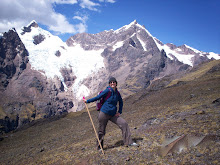



I am a teacher at a charter school in Chicago and am interested in building real readers through critical analysis of literature and writing in all its forms.

At the start of the day at Manos Unidas, a school for children with special needs in Cusco, Peru students file in through the bright blue doors and hurry to their classrooms. Ruth, the primary classroom teacher, works with five students age five and up, who trickle in. As they arrive, Ruth helps them hang their backpacks on nails, and sit on the floor where they start their day working with blocks. The students, who are still adapting to coming to school, are learning the most basic skills—how to sit in a group, table permanence (the idea that when you are at your seat, you are working), following one-step directions—not to mention the academic and functional skills that Ruth wants them to learn, like identifying colors and shapes, and using alternative communication to express their wants and needs.
Ruth and her students are the latest class to join Manos Unidas. The school is now at capacity with seven morning classes full of students who have a variety of disabilities (autism, developmental delays, Down Syndrome, and others). In the afternoon, the schools is filling up with students with learning disabilities or cerebral palsy who attend therapy and extracurricular programs.
In Cusco, Manos Unidas is one of a kind; Peru doesn’t offer special education programming for students. To fill the need, the Manos Unidas program was started in 2008 by Celeste Marion, an ABA therapist from Seattle, and Mercedes Delgado, a teacher in Cusco. As the program’s reputation has grown, students come from as far as two hours away.
In July and August, this summer, I volunteered for ten days with Ruth’s class. The work that Marion and Delgado are doing is fantastic. The kids are obviously learning and developing academic and social skills. Manos Unidas has a wonderful energy, the kids are so obviously excited to be there, eager to engage with the staff and learn. But, perhaps the most important thing that I saw was a dedication to training Peruvian teachers in special education best practices. There is currently no special education training for teachers in Peru and Marion relies on her own expertise, as well as volunteers to help bring best practices to her staff. Undoubtedly, in the long run, this will make Manos Unidas a locally sustainable school that isn’t dependent on anything but the expertise and creativity of their staff.
Above are the pictures of the students that I met during my visit (photo credit: Dawn Magnusson). For more information, please visit www.manosunidasperu.net.

